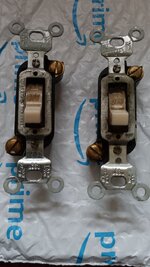Mercury switches are still made but not too common.
Ever see or use a mercury diffusion pump? We had a couple when I was in college.
I had a mercury diffusion pump sitting on the shelf in my office at my last job until EHS came after me about the amount of mercury I had sitting on my office shelf of things I'd "saved". I managed to keep the high precision calorimetry thermometer(with a bulb the size of my thumb), a McLeod gauge, and a nice old manometer. I had a case for keeping the manometer and McLeod, and even though I never used the thermometer I pointed out that it was at least sealed and also the replacement cost.
My mass spectrometer has an oil diffusion pump on it, which of course works the same as mercury but uses a hideously expensive ester based oil. They are nice in that they "just work" other than an oil change every decade or two(not joking about that-and I probably should change mine even though it looked clean the last time I checked it) and basically only have two parts that can fail-the heater and the temperature sensor. They're also a pain in that they give a lot of background, plus can backstream into the mass spec and make a gigantic mess if you inadvertently break vacuum(even a little bit...) while the pump is still hot. You can also of course char the oil if you let oxygen in, although the ester oils are MUCH more tolerant of this than older silicone oils. I think the current gen Agilents put a Peltier cooler between the diff pump and the vac manifold to both hold down the background and to catch some backstreaming. I think there's also a baffle somewhere in there that can be closed, but I forget exactly how that works(or maybe that was something Varian did...). The diffusion pump also takes a long time to pump down-Agilent optimistically claims 45 minutes, but real world experience tells me that at best if I pump down in the morning I MIGHT get a relatively clean tune before I leave for the day, but I probably need to let it sit overnight. The same instrument with a turbo pump will pump down in 15 minutes at most and most will tune well in ~4 hours. I had a Varian Triple Quad(300TQ) at a previous job with a vac manifold about 4x the size of the little Agilent single quads, and it would manage 4 hours also(and given me an ultimate vacuum of 10^-7 torr at typical GC flow rates provided I was dumping a bunch of methane in for chemical ionization and/or argon for CID).
My current mass spec is 2 or 3 generations old now and is branded Hewlett Packard, but at least it's new enough that Agilent does still provide some limited tech support on them and were even still selling refurbs until a few years ago.
I think in the mass spec world, unless there's someone I'm not aware of, Agilent is the only company that even offers diffusion pumps anymore. They're definitely a budget option, and it doesn't help that in the interest of size and noise they basically put the smallest foreline pump they can get away with. That doesn't help either because the tiny little foreline pumps run super hot and give you high oil backgrounds also. In the past, I'd swap out the tiny little pumps for an Edwards E2M2 or RV3(or my old favorite, a Varian DS102) and get an order of magnitude improvement in high vac pressures along with typically a 5x-50x improvement in LODs(depending on the specific instrument and of course sample specific) on diffusion pumps thanks to the lower background from the vacuum system.
Fun stuff...I don't get to do nearly as much mass spec work as I use to. We just have the one GC-MS where I am now, which I did resurrect from the dead(really-it was in pieces when I came here, and I ended up having to take things apart that the maintenance manuals tell you to absolutely never do under any circumstances) but it doesn't get much use now.

